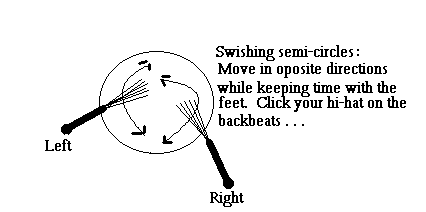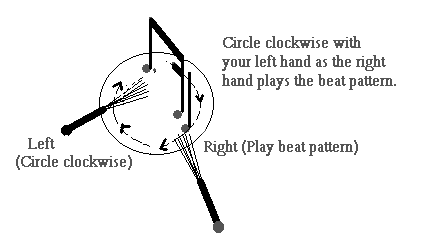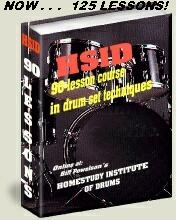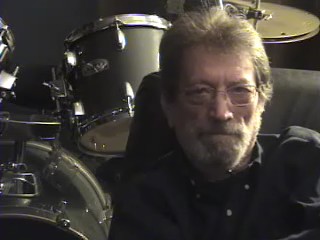Brushes come in all sizes and shapes, but in this lesson we are speaking primarily of old-fashioned wire brushes used to swish, slap and scratch rhythms at low volumes. Wire brushes were designed back in the days before loud amplification was the norm. Drummers of old were always the loudest member of the band and they took a lot of heat for it back then. Prior to the 1930s a GOOD drummer was to be felt and not heard! Much of the music from that era was 100% acoustic. All the instruments were unamplified. This meant the drummer was always walking-on-eggshells for fear of drowning out the rest of the group. The use of wire brushes helped those old-time drummers keep their jobs.
Drummers of that era developed some rather unique and interesting techniques with their brushes and several classic, brush-stroke patterns emerged. It seems prudent that, we of this more modern era would be wise and prudent to learn what we can about those classic moves . . . Then maybe add our own touches too.
Sooner or later in every drummers career . . . there will be a gig or a situation where ANY volume is too much volume. That may be the day this little lesson will prove its value.
To begin with, I should say that brushes may be used exactly like a pair of drumsticks. There isn't a thing wrong with simply grabbing the brushes and playing as though you have a pair of sticks in your hand. You may attack the cymbals, toms, snare and hi-hat in exactly the same fashion as always. As you do . . . you'll begin to gain a special feel for the brushes. You'll quickly see that certain aspects of brushes are quite different from the sticks you may be accustomed to. The bounce and crush effects we have come to depend on when using sticks will for the most part be lost. But, after working with brushes for a little while we discover certain other special techniques that simply can not be achieved with sticks. New and different tones can be pulled from a drumset with brushes . . . by slapping, swishing and scratching. It can be a lot of fun . . . just experimenting with all the possibilities that brushes have to offer. There are some songs and situations where sticks just won't do! The only way to get certain effects is with a pair of brushes.
- As a project . . . experiment with all your favorite beats, using brushes as if they were sticks.
- Discover that by adjusting the 'fan' of the brushes, it is possible to make them behave more (or less) like the sticks we are so accustomed to.
CLASSIC BRUSH STROKES
Here are a couple of brush stroke ideas you may want to master.

Here you will simply be scratching or swishing the brushes and you play the bass drum and hi-hat. This brush-stroke sounds a lot like bacon frying in a skillet. Think of two parentheses marks () . . . You are simply going to scratch those marks, one inside the other, in-time with the music. This stroke might be thought of as a bush-stroke substitute for a Swing beat or fast 4/4. Remember to kick the bass and click the hi-hat on the backbeats as you play the above pattern on the snare with both hands.

This brush-stroke technique is a bit like patting your head and rubbing your stomach at the same time. It may take a few minutes to get the hang of it. With this brush-stroke, the left hand circles constantly while the right hand plays the beat. You will be circling and scratching the snare head in a clockwise motion with the left. The trick is to time your left-hand circles so that you can maintain the beat (ie; 16ths, Blues, 8th rock, Shuffle, Swing, Waltz or any other.) While the left is at the 12 o'clock position, your right will be at the 6 o'clock position, then as the left swings around into the 6 o'clock position, the right-hand will glide over the top of the left-hand, to the 12 o'clock position. Also as you are doing this, you learn to 'slap' the backbeat portion of the rhythm (right-handed) with more force, thus accenting the backbeats. Don't forget the feet! All the while . . . both feet are keeping tempo on the bass and hi-hat.
The circling motion of the left-hand tends to fill up the air with a swishing sound while simultaneously helping to muffle some of the ringing tones coming from the snare drum.
THIS IS A GOOD REASON TO USE A COATED BATTER HEAD . . . Incidentally . . . I prefer using a coated-snare-batter just so my brushes will sound-off a little better. The coating is really just a fancy paint that is sprayed over an otherwise slick batter head. The off-white paint gives the appearance of real cowhide. It gives the head a rougher, more abrasive surface and is much better for achieving sizzling brush-strokes. I never use a slick snare batter for that reason. A slick batter head just won't get the effect we are looking for here.
PARTING THOUGHTS . . .(TIPS)
Drumstick manufacturers have come up with a ton of innovative new brush type utensils. You will find brush-stick combinations, brush-mallet combinations, Blasticks, Hotrods and a host of other new and inviting brush-like tools. I think they are all great. I am especially fond of the brush-mallet combination. This tool has a mallet on one end and a brush on the other. Some special songs require very special effects! It may be best to purchase and experiment with all the tools you can afford!
Remember . . . the objective is to be prepared for any situation! Try to equip yourself with all the tools you can get your hands on . . . and the expertise necessary to dazzle your audience . . . no matter what the song or situation may be.
MORE . . . Drum Set Lessons.
Next . . . Learn some Latin Beats.
QUESTION: How do we REALLY win?
The BEST correct answer is here . . .
Finite To Infinity
3 very important questions
IS IT POSSIBLE THAT YOUR 'NATURAL GIFT' OF RHYTHM CAN BE DOUBLED WITH ONLY A LITTLE ADDITIONAL (PREVIOUSLY UNAVAILABLE), KNOWLEDGE?
IS THERE A 'KNOWLEDGE GAP' IN YOUR OWN UNDERSTANDING OF 'RHYTHM'?
IS IT POSSIBLE TO GAIN A COMPLETE AND THOROUGH UNDERSTANDING OF 'ALL RHYTHM', WITHIN ONLY A COUPLE HOURS OF EASY, AND FASCINATING, STUDY ?
Answers: YES! YES! YES!
Get All Products Here

GET ALL THE PRODUCTS AT ONE LOW PRICE.
SURPRISES ABOUND!!!! . . . For those with a bit of generosity in their soul.
CLICK HERE , to see what I mean.
Intermediate & Advanced Drummers
- Drum Instructors Wanted
- Teach My Lessons and Methods
- Up to $60.00/hour
Pre-School Drummer?
Can we teach rhythm to pre-schoolers? YES!
This is a very short course, designed to help adults plant the seeds of rhythm into children of nearly any age. Click Here!!
Make CASH $$$ Now!!!

FREE ELECTRONIC BOOK BONUS (also included) BUSINESS OPPORTUNITY:
- * MAKE BIG MONEY SELLING USED DRUMSETS!
- * INSIDER HARDBALL-BUYING-TIPS AND SECRETS.
- * UNIQUE RECOVERING SECRETS
Support Us Today!!
Support this site and and gain an advetising bargain with the deal. Place a permanent ad here.
